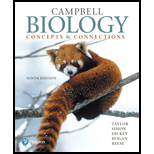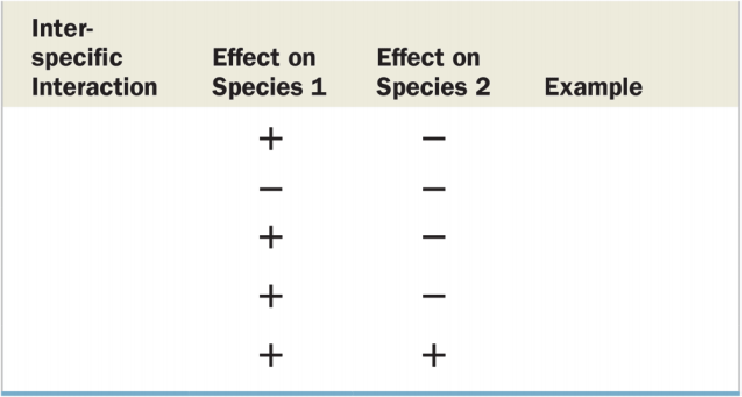
Concept explainers
Fill in the blanks in the table below summarizing the interspecific interactions in a community.

To complete: The blanks summarizing the interspecific interactions in a community.
Introduction: While surviving in an ecosystem, many species interact with each other. These interactions can be mutually beneficial or harmful for one or the other. There are five main types of interspecific interactions, namely, predation, competition, herbivory, parasitism, and mutualism.
Answer to Problem 1CC
Tabular representation: Table 1 represents the interspecific interactions in a community as follows:
| Interspecific interactions | Effect on species 1 | Effect on species 2 | Examples |
| Predation | + | - | Osprey/fish |
| Competition | - | - | Hyenas/vultures |
| Herbivory | + | - | Deer/shrub |
| Parasitism | + | - | Tapeworm/horse |
| Mutualism | + | + | Clown fish/anemone |
Table 1 Depicts the interspecific interactions in a community.
Explanation of Solution
The five types of interspecific interactions are as follows:
Predation: In predative interspecific interactions, one species preys on the other species for food or territory. It is a type of +/- interaction where one species benefits and the other species does not benefit. For example: interaction between a deer and a lion is predation.
Competition: It is the competitive interspecific interaction where two different types of species are competing for the same resource. Neither of them benefits from this, so it is a type of -/- interaction. For example: the interaction between vulture and hyenas.
Herbivory: It is the interaction between the herbivores and the plants. This interaction is a type of +/- interaction where the deer is benefited while the plant is not. For example: an interaction between deer and grass is herbivory.
Parasitism: It is parasitic form of interspecific interaction that involves one organism using the other for food and shelter. One organism such as the tapeworm inhabits the gut or any other part of the other organism such as the horse. This interaction is a +/- interactions, where only one is benefitted.
Mutualism: In this interaction, the organisms that are interacting are mutually beneficial for each other. One species provides one factor, while the other species provides another factor, for example, in the case of mycorrhiza, the fungus is in mutual interaction with the roots of the gymnosperm tree. The fungal element provides minerals and water from the soil, while the tree provides the nutrients. It is a +/+ form of interaction as both the organisms are benefitted.
Want to see more full solutions like this?
Chapter 37 Solutions
Campbell Biology: Concepts & Connections (9th Edition)
- One of the ways for a cell to generate ATP is through the oxidative phosphorylation. In oxidative phosphorylation 3 ATP are produced from every one NADH molecule. In respiration, every glucose molecule produces 10 NADH molecules. If a cell is growing on 5 glucose molecules, how much ATP can be produced using oxidative phosphorylation/aerobic respiration?arrow_forwardIf a cell is growing on 5 glucose molecules, how much ATP can be produced using oxidative phosphorylation/aerobic respiration?arrow_forwardHow do i know which way the arrows go?arrow_forward
- Identify the indicated structure (Saprolegnia). a. antheridium O b. oospore c.sperm d. auxospore e. tetraspore Of. zygosporearrow_forwardUsing information from the primary literature (several references have been provided as a starting point below) please answer the following question: Based on your review of the literature on rewilding, what are the major scientific pros and cons for rewilding? Please note that the focus of this assignment are the (biological) scientific issues associated with rewilding. As will be discussed in class, there are a number of non-scientific issues involved or implicated in rewilding, all ultimately affecting the public acceptability of rewilding. Although these issues are important – indeed, critical – in this assignment you should focus on the biological science issues and questions. Details: You must enumerate at least two pros and at least two cons. Your answer should be no more than 500 well-chosen words, excluding references. Think carefully about how best to organize and structure your answer. Aim for high information density: say a lot, but say it succinctly. Recall Nietzche’s…arrow_forwardUsing information from the primary literature (several references have been provided as a starting point below) please answer the following question: Based on your review of the literature on rewilding, what are the major scientific pros and cons for rewilding? Please note that the focus of this assignment are the (biological) scientific issues associated with rewilding. As will be discussed in class, there are a number of non-scientific issues involved or implicated in rewilding, all ultimately affecting the public acceptability of rewilding. Although these issues are important – indeed, critical – in this assignment you should focus on the biological science issues and questions. Details: You must enumerate at least two pros and at least two cons. Your answer should be no more than 500 well-chosen words, excluding references. Think carefully about how best to organize and structure your answer. Aim for high information density: say a lot, but say it succinctly. Recall Nietzche’s…arrow_forward
- Now draw a rough sketch of what the control data might look like if in addition to the specific binding, there was also a considerable amount of nonspecific binding (again using a normal dose/response curve) (do % total bound ligand vs concentration)arrow_forwardWhat are functions of cuboidal cells in the kidney? Select all that apply. Concentration of gases Dilution of chemicals Secretion of molecules Nutrition to tissues Support of tissues Absorption of moleculesarrow_forwardquestion1 In plants, epithelial tissue is only found as the outermost cell layer and acts as a barrier. In humans, epithelial tissue is found inside the body as well as on the surface. What function(s) does/do epithelial tissue carry out in humans? Select all that apply. Waste storage Filtration Oxygen transport Protection Diffusion Osmosis Absorptionarrow_forward
 Biology Today and Tomorrow without Physiology (Mi...BiologyISBN:9781305117396Author:Cecie Starr, Christine Evers, Lisa StarrPublisher:Cengage Learning
Biology Today and Tomorrow without Physiology (Mi...BiologyISBN:9781305117396Author:Cecie Starr, Christine Evers, Lisa StarrPublisher:Cengage Learning Biology (MindTap Course List)BiologyISBN:9781337392938Author:Eldra Solomon, Charles Martin, Diana W. Martin, Linda R. BergPublisher:Cengage Learning
Biology (MindTap Course List)BiologyISBN:9781337392938Author:Eldra Solomon, Charles Martin, Diana W. Martin, Linda R. BergPublisher:Cengage Learning
 Concepts of BiologyBiologyISBN:9781938168116Author:Samantha Fowler, Rebecca Roush, James WisePublisher:OpenStax College
Concepts of BiologyBiologyISBN:9781938168116Author:Samantha Fowler, Rebecca Roush, James WisePublisher:OpenStax College Human Biology (MindTap Course List)BiologyISBN:9781305112100Author:Cecie Starr, Beverly McMillanPublisher:Cengage Learning
Human Biology (MindTap Course List)BiologyISBN:9781305112100Author:Cecie Starr, Beverly McMillanPublisher:Cengage Learning





